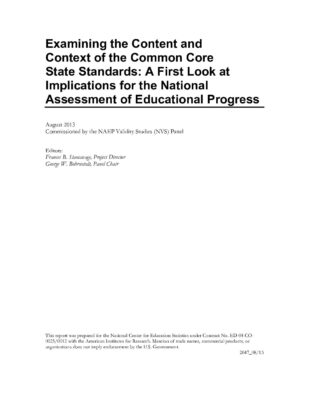Resource Hub
Explore guides, research papers, policy briefs, and tools to aid decisions on standards and assessments.
Examining the Content and Context of the Common Core State Standards: A First Look at Implications for the National Assessment of Educational Progress
The Common Core State Standards (CCSS) have been widely adopted by states. According to this report, these new standards, and the assessments being built to measure them, offer the possibility of far greater uniformity in curriculum and assessment across the nation than has characterized U.S. education in the past. In addition, the authors contend that the CCSS embody many emerging themes of education reform. In this context, the NAEP Validity sutdies Panel (NVS Panel) devoted a substantial portion of its annual validity research agenda in 2011 and 2012 to exploring the relationship between NAEP and the CCSS, and to considering how NAEP can work synergistically with the CCSS assessments to provide the nation with the most useful information about educational progress. This volume includes two substantial studies exploring the relationship between the content of the NAEP mathematics, reading, and writing assessments and the CCSS in mathematics and English language arts (ELA). These two content studies are complemented by two shorter white papers that explore (1) the potential for incorporating learning progressions into NAEP assessments, and (2) the implications for the NAEP program of coming changes in psychometric approaches to statewide testing.


This report produced by the NAEP Validity Studies Panel examines the alignments between the NAEP and CCSS and the implications of the challenges and opportunities the NAEP faces in addressing the changes to the current assessment landscape. This is a highly technical and detailed document that will not be readily accessible to the general audience, but provides a deep examination of alignment between the CCSS and NAEP. The very high-level overview is that the alignments in both mathematics and English language arts are fairly strong, although in both subjects, some of the concepts and skills are introduced at an earlier grade level in the CCSS than tested on the NAEP, higher rigor and deeper complexity are required at earlier grade levels in the CCSS, and there exist shifts in the conceptual framing of skills in the new standards. The authors also note that the CCSS integrate writing within the English language arts, and across disciplines, which marks a distinct shift in the NAEP standards frameworks. These are not wholly unexpected conclusions for the reader, and set up a foundation to discuss the implications these have on the role the NAEP plays in providing a benchmark for evaluating student achievement across the nation. The two white papers discuss the fact that greater and deeper implementation of the Common Core across states is needed for it to be feasible to add the CCSS learning progressions into the structure and reporting of the NAEP, as well as the implications of increased computerized testing and decreased unique state assessments. The final conclusion across the panel is that while the CCSS and new college- and career-readiness standards present shifts to how and when concepts and skills are taught, the NAEP can and should continue to play a valuable role as an independent monitor of students’ academic achievement and progress across states.